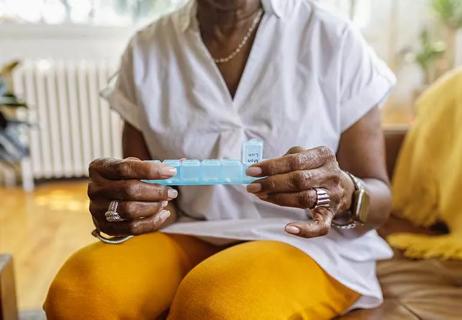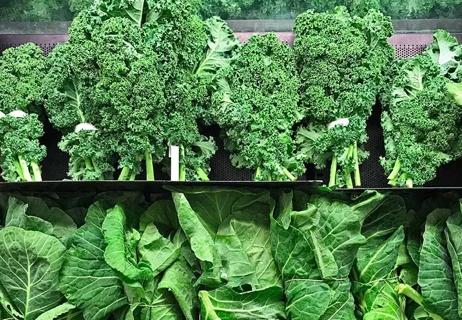Both micronutrients support body functions, but there are key differences, like what foods have them and what jobs they do

Vitamin K: Not the same as potassium. But you’re not alone if you thought they were.
Advertisement
Cleveland Clinic is a non-profit academic medical center. Advertising on our site helps support our mission. We do not endorse non-Cleveland Clinic products or services. Policy
“People may think that vitamin K and potassium are the same nutrient because the letter K is the symbol for potassium on the periodic table of elements,” says registered dietitian Natalie Crtalic, RD, LD. “And of course, vitamin K has the letter K in it.”
Fun fact: The K for potassium may come from the word kalium, which is Medieval Latin for potash or potassium.
But vitamin K and potassium come from different foods and provide distinct health benefits. Plus, you only need a little vitamin K and just the right amount of potassium (not too much!) to stay healthy.
To help clear up any confusion, Crtalic shares key differences — and some similarities — between vitamin K and potassium.
Vitamin K and potassium are both micronutrients. They help keep your heart, blood pressure, muscles and body systems healthy.
“Your body doesn’t make vitamin K or potassium. You have to get both nutrients from foods,” says Crtalic.
But that’s basically where the similarities end.
Minerals like potassium come from inorganic (nonliving) sources. Vitamin K and other vitamins come from organic (living) sources.
Advertisement
Your body needs vitamin K and potassium to perform a range of activities.
Vitamin K is mostly known for its blood-clotting abilities. It helps promote wound healing and minimizes bruising. And vitamin K is also essential for:
Potassium acts as an electrolyte. It carries a positive electric charge throughout your bloodstream to support body functions, such as:
Certain foods like avocados, kale and spinach have both vitamin K and potassium. But generally, you get these nutrients from different foods.
Vitamin K is a fat-soluble vitamin, which means it breaks down in fat in your bloodstream. Your body absorbs foods high in vitamin K when you pair them with some healthy fat. For instance, have a spinach-walnut salad with a dressing made with extra virgin olive oil.
The measurements for vitamin K and potassium differ. Vitamin K is measured in micrograms (mcg). Potassium is measured in milligrams (mg). It takes 1,000 micrograms to make 1 milligram.
The recommended dietary allowance (RDA) for each nutrient is also different. How much you need depends on your age, sex recorded at birth and whether you’re pregnant or breastfeeding.
| Age | Recommended amount |
|---|---|
| Birth to 6 months | 2.0 mcg |
| Infants 7 to 12 months | 2.5 mcg |
| Children 1 to 3 years | 30 mcg |
| Children 4 to 8 years | 55 mcg |
| Children 9 to 13 years | 60 mcg |
| Teens 14 to 18 years | 75 mcg |
| Women 19 and older | 90 mcg |
| Men 19 and older | 120 mcg |
| Pregnant or breastfeeding teens | 75 mcg |
| Pregnant or breastfeeding adults | 90 mcg |
| Age | |
| Birth to 6 months | |
| Recommended amount | |
| 2.0 mcg | |
| Infants 7 to 12 months | |
| Recommended amount | |
| 2.5 mcg | |
| Children 1 to 3 years | |
| Recommended amount | |
| 30 mcg | |
| Children 4 to 8 years | |
| Recommended amount | |
| 55 mcg | |
| Children 9 to 13 years | |
| Recommended amount | |
| 60 mcg | |
| Teens 14 to 18 years | |
| Recommended amount | |
| 75 mcg | |
| Women 19 and older | |
| Recommended amount | |
| 90 mcg | |
| Men 19 and older | |
| Recommended amount | |
| 120 mcg | |
| Pregnant or breastfeeding teens | |
| Recommended amount | |
| 75 mcg | |
| Pregnant or breastfeeding adults | |
| Recommended amount | |
| 90 mcg |
Source: National Institutes of Health
| Age | Recommended amount |
|---|---|
| Birth to 6 months | 400 mg |
| Infants 7 to 12 months | 860 mg |
| Children 1 to 3 years | 2,000 mg |
| Children 4 to 8 years | 2,300 mg |
| Girls 9 to 13 years | 2,300 mg |
| Boys 9 to 13 years | 2,500 mg |
| Girls 14 to 18 years | 2,300 mg |
| Boys 14 to 18 years | 3,000 mg |
| Women 19 and older | 2,600 mg |
| Men 19 and older | 3,400 mg |
| Pregnant teens | 2,600 mg |
| Breastfeeding teens | 2,500 mg |
| Pregnant adults | 2,900 mg |
| Breastfeeding adults | 2,800 mg |
| Age | |
| Birth to 6 months | |
| Recommended amount | |
| 400 mg | |
| Infants 7 to 12 months | |
| Recommended amount | |
| 860 mg | |
| Children 1 to 3 years | |
| Recommended amount | |
| 2,000 mg | |
| Children 4 to 8 years | |
| Recommended amount | |
| 2,300 mg | |
| Girls 9 to 13 years | |
| Recommended amount | |
| 2,300 mg | |
| Boys 9 to 13 years | |
| Recommended amount | |
| 2,500 mg | |
| Girls 14 to 18 years | |
| Recommended amount | |
| 2,300 mg | |
| Boys 14 to 18 years | |
| Recommended amount | |
| 3,000 mg | |
| Women 19 and older | |
| Recommended amount | |
| 2,600 mg | |
| Men 19 and older | |
| Recommended amount | |
| 3,400 mg | |
| Pregnant teens | |
| Recommended amount | |
| 2,600 mg | |
| Breastfeeding teens | |
| Recommended amount | |
| 2,500 mg | |
| Pregnant adults | |
| Recommended amount | |
| 2,900 mg | |
| Breastfeeding adults | |
| Recommended amount | |
| 2,800 mg |
Source: National Institutes of Health
Overdoing it (or underdoing it) on vitamin K is rare. But the same can’t be said for potassium.
It’s possible — and even dangerous — to have too much potassium in your blood. High potassium levels (hyperkalemia) can cause muscle weakness and heart rhythm problems like atrial fibrillation.
“People with kidney problems are most at risk because their kidneys have a harder time filtering out the mineral,” notes Crtalic.
But it’s almost impossible to get too much vitamin K from foods (and few people take vitamin K supplements, she says). However, the vitamin’s blood-clotting effects can interfere with blood-thinning medications.
“If you take blood thinners, talk to your healthcare provider. They’ll likely recommend regular blood tests to check vitamin K levels,” says Crtalic.
Advertisement
Low potassium levels (hypokalemia) can cause heart palpitations, low blood pressure and muscle cramps and weakness. Potassium levels may drop too low after prolonged bouts of vomiting or diarrhea. People with inflammatory bowel disease (IBD), disordered eating and alcohol use disorder are particularly at risk.
But a vitamin K deficiency is almost unheard of in the U.S.
“Most of us easily get the recommended amount of vitamin K each day with our meals,” shares Crtalic.
Plus, your liver and fatty tissue store fat-soluble vitamins like vitamin K for later use. This differs from water-soluble vitamins, which quickly leave your body when you pee.
While vitamin K and potassium share some similarities, they each play different roles in keeping you healthy.
“It’s important to get enough vitamin K and potassium every day — preferably from foods, not supplements,” reinforces Crtalic.
Advertisement
Learn more about our editorial process.
Advertisement

Calcium, vitamin D and magnesium are essential — but you should supplement under doctor’s orders

It’s always best to talk to a healthcare provider before taking any supplements to avoid toxicity

From leafy greens to heart-healthy oils, the selection is abundant

Vitamin K2 foods aren’t the usual suspects

Vitamin K2 is gaining recognition for its effects on blood clotting, heart health and bone health

It helps your bones stay strong and your blood clot, but it may also do so much more

These delicate green sprouts can give you an extra dose of vitamin K and other nutrients — but they’re not safe for everyone

Edamame, lentils and chicken breast are good sources of protein

The best parenting style balances enforcing rules and showing plenty of love

Tips include cutting back on sugar, focusing on exercise and managing stress

It can be harder to let go when you’ve invested time, energy and emotions — but it might be the healthier choice long term